ザ・ D-デイビーチ にあります カルバドス そして マンシュ の部門 ノルマンディー, フランス。彼らは連合国の西ヨーロッパ侵攻の着陸場所でした 第二次世界大戦.
訪問するのに最適な時期は、6月6日の記念日であり、その機会を記念する多くの記念式典があります。たくさんの 再現 グループが参加し、ページェントリーと雰囲気を加えます。教会の鐘が町で鳴り響き、解放の記念日を祝います。フランスの人々はあなたに会えてうれしいでしょう-これらの人々は覚えています、そして歓迎は暖かくなります。
1944年から長い年月が経ち、生き残った老兵はそれほど多くありませんが、6月6日にこれらの海岸に戻ることが多い兵士たちです。 2014年の70周年を記念して、90歳のイギリス海軍のベテランであるバーナードジョーダンは、健康のためにナーシングホームを離れる許可を拒否されました。彼はこっそりととにかくフランスへのフェリーに乗りました。 93歳のアメリカ人と89歳のブリトンの2人の年配の落下傘兵が、70年前と同じようにその日フランスに飛び込んだ。
理解する
- 見る ヨーロッパの第二次世界大戦 文脈のために。

ここに見える高台はオマハビーチへの着陸を特に困難にしました
1944年6月6日(D-Day)、待望の北西ヨーロッパ侵攻(オーヴァーロード作戦)が連合国の海岸への上陸から始まりました。 ノルマンディー (ネプチューン作戦)。
ドイツ人は海岸線を、大砲、機関銃、ピルボックス、有刺鉄線、地雷、ビーチの障害物を備えた一連の拠点に変えていたため、この作業は手ごわいものでした。ドイツは北部に50の師団を持っていました フランス そしてその ネーデルラント、この侵略に対して即座に使用される位置に少なくとも12を含む。
連合国は、暴行地域への大規模な空爆と海上砲撃に続いて、米軍、英国軍、カナダ軍の同時着陸を開始しました。その日、約16万人の地上部隊が上陸し、およそ半分がアメリカ人で半分が連邦でした。約4,000隻の船、11,000機の飛行機、そして何千人もの船員と空軍兵もこの作戦に参加しました。
ヨーロッパの連合軍の総司令官は、後に国の大統領となるアメリカのドワイト・D・アイゼンハワー将軍であり、イギリスのバーナード・モンゴメリー将軍は、ノルマンディーに上陸すると地上軍を担当しました。ドイツ側では、エルヴィン・ロンメル将軍が沿岸防衛を担当し、陸軍元帥ゲルト・フォン・ルンドシュテットがこの地域で全体的な指揮を執っていました。
これは歴史上最大の海上侵攻であり、連合国の重要な勝利でしたが、生命と物資の両方のコストは莫大でした。
着陸
世界の目があなたに向けられています。自由を愛する人々の希望と祈りは、どこでもあなたと一緒に行進します。 – ドワイト・D・アイゼンハワー将軍
真夜中過ぎに、24,000人の男性が、重要なポイントを確保するために、側面にパラシュートとグライダーでやって来ました。その後、5つの別々のビーチへの主な海上着陸が夜明けに始まりました。東から西への攻撃は次のとおりです。

- イギリス第6空挺師団、カナダ大隊1個、左側面近く カーン
- 記念ペガサス, av du Major Howard、14860 Ranville, ☏ 33 2 31 78 19 44. ペガサス橋の占領は、グライダーパイロット連隊と第6空挺師団の目覚ましい成果でした。物語は博物館でよくカバーされており、展示品にはオリジナルのペガサス橋とホルサグライダーが含まれています。橋の横には、第6イギリス空挺部隊の記念碑がいくつかあります。 7.50€.
- 1 ソードビーチ (英国人).
- 2 ジュノビーチ (カナダ人).
- 3 金の砂浜 (英国人).
- 4 オマハビーチ (アメリカン).
- 5 ユタビーチ (アメリカン).
- 米国の第82空挺師団と第101空挺師団。 サントメールエグリーズ
すべてのビーチには記念碑や美術館があります。を参照してください ビーチ 詳細については、以下のセクションをご覧ください。
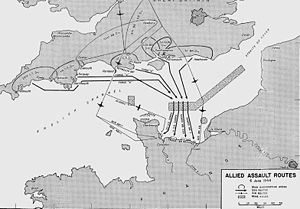
海上部隊が上陸し始めたとき、連合軍の兵士は地雷や障害物にもかかわらず、強い反対に対して浜辺を襲撃しました。彼らは機関銃の火で一掃されたオープンビーチを横切って競争し、ドイツの銃の位置を襲撃しました。激しい白兵戦で、彼らは町や丘に向かって戦い、その後内陸に進んだ。当初、要塞化された位置にいたドイツ軍は連合国よりも損失が少なかったものの、死傷者はすべての地域と両側で多かった。
その日の終わりまでに、第3イギリス師団はカーンから3マイル以内にあり、第3カナダ師団はその中間目標で十分に確立されており、第50イギリス師団はバイユーからわずか2マイルでした。アメリカゾーンでは、第4師団が内陸に4マイルの深さの侵入を確立し、第82師団が一晩中戦ったサントメールエグリーズの手の届くところにありました。オマハビーチでは、ドイツ人は着陸地点の上の断崖からの地形の利点を持っていましたが、そこにも海岸堡が確立されていました。
それは素晴らしい成果でした。恐るべき大西洋の壁は首尾よく破られました。 D-Dayの終わりまでに、連合国は15万人以上の軍隊を海上および空路でフランスに上陸させ、900両の戦車、600門の大砲、約4,000トンの補給品を含む、6,000両の車両を上陸させました。驚くべきことに、連合国はそれを行うことで完全な驚きを達成しました。 。より多くの兵士と物資が前進を続けるために上陸していました。 7月初旬までに連合国はフランスに100万人以上の兵士を擁し、8月には合計で200万人に達しました。
他の同盟国
主な侵略軍はアメリカ、イギリス、カナダでしたが、他のいくつかの同盟国にはオブザーバーが出席していたか、他の方法で関与していました。
ヨーロッパの捕われた国は、彼ら自身の解放に大きく貢献しました。彼ら全員(ドイツでさえ)にはレジスタンス運動があり、いくつかはより正式な部隊も関わっていました。 D-Dayには、ビーチに自由フランスがあり、ノルウェー、オランダ、ポーランド海軍の船が沖合にありました。ポーランドの装甲師団は、ノルマンディーでカナダ軍の一部として戦った。 D-Dayからフランス、ベルギー、オランダでのすべての戦闘まで、抵抗はドイツの通信と緊急に必要な援軍と補給品を移動する彼らの努力の両方を混乱させました。 D-Dayに、無料のフランス空挺部隊が投下されました ブルターニュ (ノルマンディーの西の地域)それを助けるために;彼らの成功は、アメリカの勝利の要因でした。 コタンタン半島 D-Dayの直後とブルターニュで。
この戦争の時までに 大英帝国 ピークをはるかに超えていましたが、それでも考慮すべき力でした。 D-Dayには、上陸部隊の約半分がイギリス軍またはカナダ軍であり、帝国はそれを超えて貢献しました。ニュージーランドの商船が配達した軍隊の船と、イギリス空軍、イギリス空軍、カナダ空軍のイギリス空軍の飛行隊が、イギリス空軍とアメリカ空軍とともに活動していました。また、英国のサービスのすべての支部には、帝国の他の国からの人員が含まれていました。
町
ビーチへの訪問の通常の拠点は、カーンまたはバイユーのいずれかです。すべてのビーチはどちらからでも簡単にアクセスできますが、どちらもビーチに面していない少し内陸にあります。
- カーン の部門の主要都市です カルバドス、そしてルーアンに次ぐノルマンディーで2番目に重要な都市。さまざまなアトラクションと素晴らしいショッピングがあります。海岸から約15km(10マイル)です。ザ・ メモリアル・ド・カーン 博物館では、ビーチのツアーを毎日提供しています。
- バイユー は小さな町で、海岸と侵略着陸エリアの中心に近いです。乗り降りが簡単で、訪れるのに便利です。 オマハ, ゴールド そして ジュノ ビーチセクター。興味深い歩行者セクションのある素晴らしいレストランやショップがあります。
他の選択肢があります。
- ウイストラム 着陸エリアの東端の海岸にあります。 ソードビーチ、からフェリーがあるので便利かもしれません ポーツマス.
- アロマンシュレバン 中央近くの海岸にあります 金の砂浜、そしてD-Dayの直後に「桑の港」(人工港)が建設された場所の1つでした。
- サントメールエグリーズ 西の内陸にあります ユタビーチ;アメリカの空挺部隊は海上侵攻の数時間前にこの地域に投下され、町とその周辺で激しい戦いを繰り広げました。
この地域には他にもたくさんの村があります。ほとんどが非常に絵のようで、観光客を収容することができます。
Dデイの数週間後に重要な戦闘が行われた実際の着陸エリアの外にある町の1つに滞在することもできます。を参照してください ノルマンディーキャンペーン 詳細については、以下のセクションをご覧ください。
この地域のほぼすべての町が戦争中に被害を受けました。いくつか—など カーン, サンロー, ビール そして ファレーズ —ほとんど破壊されました。しかし、それらはすべて再建されてから長い年月が経ちました。 バイユー 幸いにも損傷はなかったので、まだ中世の特徴を保持しています。
気候
ノルマンディーは温帯の海洋性気候です。夏は暖かく、冬は穏やかです。しかし、雨は一年中気候の一部であり、冬は夏よりも雨が多くなります。進行中の雨はほとんどの場合休暇を台無しにするのに十分ではありません、そしてそれは利益を持っています、自然は信じられないほど緑豊かで緑です。冬は時々雪や霜も見ますが、一般的に冬の気候はかなり穏やかです。
夏はイギリス南部よりも少し暖かく、1日あたり最大8時間の日照があります。サイクリストは、フランスの他のほとんどの地域ほど暑くなく、内陸のフランスよりもイングランド南部と比較できるため、この地域を愛しています。いずれにせよ、日焼け止めと帽子が必要です。フランスの他の地域ほど暑くはありませんが、太陽はまだ力強く打ち下ろしています!
入れ
ノルマンディーはパリから車(車で2〜3時間)または電車(から2時間)で簡単にアクセスできます。 パリ サンラザール駅から カーン 中央駅)。
または、水路を渡るフェリーで3時間強で到着します。 ポーツマス に ウイストラム、最東端のD-Dayターゲット、理想的な出発点。 ポーツマス 侵略が開始された港の1つであり、 D-Dayミュージアム.
他のフェリーはに行きます シェルブール そして ルアーブル、実際の着陸エリアではありませんが、近くにあります。シェルブールは主要都市であり、6月下旬にアメリカ人によって解放されました。見る コタンタン半島 未満。 Le Havreは小さな町で、ビーチから遠く離れています。それは主に魚雷艇のためのドイツの海軍基地でした。戦争の最も激しい爆撃と地上での激しい戦闘の後、9月初旬に主にイギリス軍によって解放されました。
カーンには、村の近くに空港もあります。 カルピケ 街の西。飛行場の制御は、D-Day後の数週間で激しく争われました。
移動する
ツアー ビーチと戦場、さまざまな美術館を見て、 墓地 地域全体に行き、海辺の村や町を訪れてください。車または公共交通機関を利用した独立した旅行が可能です。

地元の観光案内所は、主要な訪問者のアトラクションをリストしたリーフレット(英語)を提供し、道路網にも標識されている7つのルート旅程の詳細を示しています。
車で
ノルマンディーでのレンタカーは、エイビス、バジェット、ユーロカー、ハーツなどのいくつかの国際チェーンを通じて手配できます。車はカーンで拾うことができます。フランスでの運転は道路の右側にあり、すべての距離と速度の測定値はkm単位です。
バス
カーンとバイユー、バイユーとウイストラム、バイユーからグランカンへのバス路線。これらは、主要な着陸ビーチのほとんどをカバーしています。すべてのルートはによって運営されています Bus Verts du Calvados☏09 70 83 00 14(非地理的番号)、および無料の時刻表は、主要な観光案内所から取得できます。
バイユー駅から、D-Dayビーチへのバスに乗ることができます。に バスのウェブサイト D-Dayビーチへのバス路線の地図があります。バス70で、オマハビーチ、アメリカ人墓地、オック岬に行くことができます。バス74で、マルベリー港のあるアロマンシュビーチに行くことができます。ウィキペディアによると、「オマハビーチの長さは5マイル(8 km)で、サントノリーヌデペルトの東からヴィエルヴィルシュルメールの西まで」で、これらの村にはバス70でアクセスできます。 、バスの数を考慮に入れてください。また、大雪の場合はバスが運行しませんので、雪の時期は事前にバスのホームページをご確認ください。
自転車
フランスでは自転車ツアーが非常に人気があり、自転車は戦場を訪れるのに最適な方法です。フランスのほとんどの主要な町や鉄道駅で自転車を借りることができます。
D-Dayには、侵入した軍隊の一部が自転車を使用しました。下のイギリス軍の写真をご覧ください。 リオンシュルメール とカナダ人 ジュノビーチ.
ガイド付きツアー
交通機関を含むガイド付きツアーをご利用いただけます。エリア内のほとんどの旅行代理店とホテルの多くは、必要に応じてこれらを手配することができます。 カーン または バイユー、一部の企業は、英語を話すガイドと一緒に戦場への半日または1日のガイド付きツアーを提供しています。
- ノルマンディー観光ツアー バイユーから5つの着陸ビーチすべてとそれ以降へのツアーを提供しています。少人数のグループでより良い体験をするために、8人乗りのバンを使用しています。ガイドはフランス語で、ほとんどがノルマンディーの地元の人々で、すべて英語を話します。
- ラルージュツアー これは、プロの戦場ガイドが率いるツアーの一例であり、主に元軍人によって実施されています。
ザ・ メモリアル・ド・カーン 博物館では、ビーチのツアーも毎日行っています。
ビーチ
D-Dayから70年以上経った今、カルヴァドスとマンシュのノルマンディーの海岸線は、美しい海辺の町と絵のように美しいビーチで平和です。町の多くには、何か-シュール-マーという形の名前があります。 サーマー 「海の上」を意味するフランス語です。海岸の後ろには、穀物畑、牛と牧草地、生け垣と農家の昔ながらの農業景観があります。
- 「時間をかけてビーチや村を散歩し、田舎のリズムによって再び規制されている田舎道を運転してください。まるでまったく荒廃したことがないかのようです。それはかわいくて心に訴えるものです。奇妙なことに、人々に最高のものをもたらします。空気中の尊敬と訪問者間の共通の絆があります。フォークは通常よりも簡単に行動し、笑顔でチャットします。」
アンソニーペレグリン、 サンデータイムズ.
しかし、戦争とD-Dayの記憶は風景に染み込んでいます。 80 km(50マイル)のD-Day侵攻海岸に沿って、ドイツの銃の据え付け場所と掩蔽壕があり、戦争記念碑と記念碑は連合軍が上陸した場所を示しています。内陸部では、ほとんどすべての村と道路のすべての曲がり角に記念碑があります。争われなかった平方ヤードはほとんどないからです。海岸と内陸に沿って、D-Day関連の美術館がたくさんあります。訪問するだけで、企業の広大さについて適切なアイデアを得ることができます。
以下のビーチの説明は、東から西の順序で構成されているため、海岸沿いのドライブツアーやサイクリングツアーの計画に使用できます。ツアーの長さは、人が訪問することを決定したサイトや美術館の数によって異なります。愛好家は数週間を費やす可能性がありますが、主要なサイトをカバーするには2〜3日で十分です。良い出発点は、どちらかの地域とD-Dayの歴史についてのオリエンテーションを取得することです。 メモリアル・ド・カーン またはアロマンシュのMuséeduDébarquement(着陸博物館)、そしてそこから探検に出かけました。
ビーチは今日でもD-Dayコードネームで知られています。
ソードビーチ
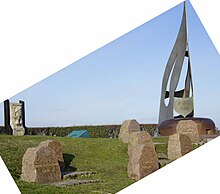

5つのビーチの中で最も東にあるソードビーチは、 ウイストラム リュクシュルメールに。イギリスの第3歩兵師団は、ウイストラムとリオンシュルメールの間の4 km(2.5マイル)のビーチに上陸しました。 41番目のイギリス海兵隊コマンドーはリオンシュルメールに上陸し、4番イギリス海兵隊コマンドーはウイストラムに上陸しました。 N°4ブリティッシュコマンドスと統合されたのは、第1波でノルマンディーの土壌に足を踏み入れる栄誉を与えられたフュージリア海兵隊第1大隊の177人のフランス人でした。ソードビーチの東側の側面で、第6イギリス空挺部隊は6月6日の早朝にパラシュートで降下し、オルヌ川とカーン運河に架かる橋を占領し、砲台を沈黙させ、D-デイビーチの東側の側面を確保しました。奇襲攻撃によりペガサス橋とホルサ橋が占領され、剣を見下ろす高台へのアクセスが確保されました。
ドイツ軍はすべてのビーチで激しく戦ったが、D-Day自体に装甲師団との反撃を仕掛けることができたのはソードだけだった。これは多くの死傷者を引き起こし、しばらくの間イギリス軍の前進を止めました。
- MuséedelaBatteriede Merville, Placedu9èmeBataillon、14810 Merville-Franceville (マービル沿岸砲廓), ☏ 33 2 31 91 47 53. 博物館はイギリスの第6空挺部隊の作戦をさかのぼります。 6.50€.
- サイトウイストラム. この美しい海辺のリゾートタウンには、要塞、記念碑、美術館、軍事墓地の遺産があり、ビーチホテル、細かな砂浜、さわやかな崖、絵葉書のような絵のように美しい漁港の間にあります。町には、フリーフレンチモニュメント、イギリス海軍とイギリス海兵隊のモニュメント、第13/18ロイヤルハザーズモニュメント、第4コマンド部隊の盾などのモニュメントがいくつかあります。キーファー記念碑はドイツの掩蔽壕の上に立っており、攻撃を主導したコマンドー中尉にちなんで名付けられました。
- 第4コマンド部隊博物館 (第4コマンド部隊博物館), 場所アルフレッドトーマス、14150ウイストラム, ☏ 33 2 31 96 63 10. この博物館では、スケールモデル、武器、ユニフォームを見て、ソードビーチに上陸したフランコブリティッシュコマンドスの物語をたどることができます。
- MuséeduMurdeL’Atlantique (大西洋の壁博物館), av du 6 Juin、14150ウイストレハム, ☏ 33 2 31 97 28 69. 大西洋の壁にあるかつての砲兵距離計のポストでは、この高さ17 mのコンクリートの塔は、この種の唯一のものであり、元の状態に復元され、再装備されています。 7€.
- Site de Lion-sur-Mer. 記念碑には、解放記念碑、王立工兵隊記念碑、および第41海兵隊コマンドー石碑が含まれます。
- Site deColleville-モンゴメリー. サフォーク連隊の第1大隊の兵士を記念して、ヒルマンバッテリーのメインブロックハウスにプラークがあります。モンゴメリー将軍の像と暫定墓地、キーファー、モンゴメリーの記念碑もあります。
- サイトダーマンビル. この地域の記念碑には、第3歩兵師団と南ランカシャー記念碑、王立砲兵記念碑、連合軍本部と野戦病院の盾、連合軍海軍の船員記念碑が含まれます。 1,003人の兵士が眠る英国墓地エルマンヴィルシュルメールは、エルマンヴィルシュルメールの近くにあります。
- MuséeDuRadar (レーダー博物館), ルート・ド・バスリー14440ドゥヴル・ラ・デリヴランデ, ☏ 33 2 31 06 06 45. ドイツの強化レーダー基地の敷地内にある博物館では、レーダーの進化と運用について説明しています。外ではドイツのレーダーヴュルツブルクを見ることができます。
このビーチの近くには2つの連邦墓地があります。を参照してください 墓地 詳細については、セクションを参照してください。
ジュノビーチ

ジュノビーチの幅は8kmで、サントーバンシュルメール、ベルニエールシュルメール、クルルシュルメールの町があります。第2カナダ機甲旅団によって強化された第3カナダ歩兵師団は、2つの旅団グループに上陸し、ビーチを越えて町に向かって戦いました。第48海兵隊コマンドーはラングリューヌシュルメールの左側面を確保しました。
海岸線は銃、コンクリートの据え付け品、ピルボックス、有刺鉄線と地雷のフィールドで剛毛でした。カナダ人が上陸したときに直面した反対は、オマハを除く他のどのビーチよりも強かった。
- ラングリューヌシュルメールサイト. 町の中心部の海岸沿いには、第48海兵隊コマンドー記念碑があります。市庁舎のエントランスホールには、第48海兵隊コマンドーのベテランとラングリューヌシュルメールの市民との友情を記念する飾り板があります。
- サントーバンシュルメールサイト. カナダ広場には50mm砲の開き窓が保存されています。ここには、ノースショア(ニューブランズウィック)連隊、フォートギャリーホース、第48海兵隊コマンドーの石碑があります。

- SitedeBernières-sur-Mer. この美しい海辺の村は、13世紀の鐘楼と67 m(220フィート)の尖塔がある教会が特徴です。カナダのラメゾンクイーンズオウンライフルは、この連隊の男性を記念しています。この家は、多くのニュース映画や公式写真に登場するビーチで有名な家の1つです。クイーンズオウンライフルの記念碑、ルレジメントドゥラショーディエール、フォートギャリーホースは、カナダのラプラスにあるドイツの掩蔽壕のそばにあります。掩蔽壕からのビーチの素晴らしい眺めがあり、劇的なD-Day攻撃のリードウェーブとして、クイーンズオウンライフルの800人の男性がここに上陸したときの様子を想像することができます。 North Nova ScotiaHighlandersプラークとJournalistsHQプラークもあります。護岸には遊歩道があり、海沿いを散歩できます。護岸に沿って東に約½km歩くと、D-Dayにカナダの女王自身のライフルがビーチを襲撃していることを示す有名な映画の映像の背景に表示される家を見ることができます。

- Site de Courseulles-sur-Mer. クルルシュルメールの町の中心部の海岸沿いには、シャーマンデュプレックスドライブ(DD)戦車が展示されています。これらの戦車は部分的に水陸両用であり、上陸用舟艇から上陸することができました。兵士たちは「DD」を「ドナルドダック」と解釈しました。これらは、ノルマンディー上陸作戦のために特別に開発された数種類の珍しい装甲の1つであり、ほとんどが米国で製造され、すべての連合国で使用され、英国の将軍が設計を担当したことから「ホバーツファニーズ」として知られています。この特定の戦車は1970年に海から回収され、復元されました。その地域で戦った連隊ユニットのバッジがそれに溶接されています。この地域の記念碑には、ロイヤルウィニペグライフルの記念碑、レジーナライフル連隊の石碑、カナダのスコットランド連隊の石碑、王立工兵隊のプラーク、解放とドゴールの記念碑があります。ロレーヌ十字の記念碑は、ドゴール将軍がフランスに帰国したことを記念しています。
- 1 センタージュノビーチ (ジュノビーチセンター), voiedesFrançaisLibres、14470クルルシュルメール, ☏ 33 2 31 37 32 17. ジュノビーチセンターは、第二次世界大戦の軍事作戦と銃後の戦争努力におけるカナダの役割を示しています。映画、オーディオ、ディスプレイは、戦前と戦時中のカナダを生き生きとさせ、戦闘体験をカバーします。中央正面のジュノパークには、通訳パネルのある遊歩道、保存されたドイツのバンカー、ビーチへと続く小道があります。ここにはほとんど開発がないので、ビーチと海の熟考を妨げるものは何もありません。上陸用舟艇とこの地域に上陸した14,000人のカナダ人から心臓を引き裂くことを目的とした、棒状の地雷、とがった金属の「ハリネズミ」、有刺鉄線、その他の野蛮人が散らばっている砂を想像できます。 7€.
- グライユシュルメールサイト. 記念碑には、解放記念碑、チャーチル「ワンチャーリー」戦車、画期的なプラーク、ロイヤルウィニペグライフル、第1カナダスコットランドプラーク、カナダプラーク、法曹院記念碑が含まれます。
このビーチの近くにカナダ人の墓地があります。を参照してください 墓地 セクション。
スタートレック 愛好家は、元のシリーズでスコットを演じた俳優のジェームズ・ドゥーナンがこのビーチで負傷したカナダ人の将校であったことを知りたいと思うかもしれません。
金の砂浜
.jpg/220px-LST-21_unloads_tanks_during_Normandy_Invasion,_June_1944_(26-G-2370).jpg)
ゴールドビーチの幅は5マイル以上あり、ラリビエール、ルアメル、 アロマンシュレバン。イギリスの第8装甲旅団によって強化されたイギリスの第50歩兵師団は、ゴールドビーチの2つの旅団グループに上陸しました。第47海兵隊コマンドーは、ポール=アン・ベッサンを占領する目的で西側の側面に上陸しました。
- MuséeAmericaGoldBeach (アメリカゴールドビーチ博物館), 2、Place Amiral Byrd、14114 Ver-sur-Mer, ☏ 33 2 31 22 58 58. この博物館では、米国とフランス間の最初の航空便の飛行について、D-DayLandingとゴールドビーチの英国の海岸堡の回顧展とともに説明しています。
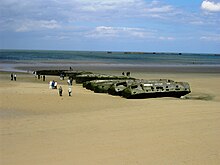
- アロマンシュ360, Chemin du Calvaire、14117アロマンシュ, ☏ 33 2 31 22 30 30. フィルム 自由の代償 1944年6月のアーカイブされた映画と現在の写真が印象的にミックスされ、円形の劇場の9つのスクリーンに表示されます。
- マルベリー港. で アロマンシュ、あなたはゴールドビーチとマルベリー港のある場所を見下ろしています。侵略には、大規模な物資を持ち込むための港が必要でした。そのため、同盟国はコンクリートのポンツーンを建造し、それを水路を横切って曳航し、沈めて港の外周を形成しました。元の115のポンツーンのうち20は、まだ波に逆らっています。
- MuséeduDébarquement (着陸博物館), Place du 6 Juin、14117アロマンシュ, ☏ 33 2 31 22 34 31. 桑の実の痕跡の前にあるこの博物館は、人工港の建設と設置において英国人が達成した驚くべき技術の偉業に捧げられています。英語とフランス語の時代のニュース映画。浮きドックが波と潮でどのように転がるかを示す印象的なダイナミックスケールモデル。マルベリー浮き橋の75フィートのセクションが外に展示されています。アメリカのハーフトラックやヒギンズボートなどの軍事機器が屋外に展示されています。 £3.90.

- バッテリー・ド・ロング, ロングシュルメール (D514道路からのアクセス(道路標識に従ってください)), ☏ 33 2 31 06 06 45. Longues-sur-Merバッテリーは、射程20 kmの150mm砲を4門収容し、6月6日の朝に連合国の艦艇にドキドキを与えました。大西洋の壁の銃の据え付けが実際にどのようなものであったかについての印象的な絵を与えて、それはその銃を保持した唯一の沿岸砲です。
- Site de Port-en-Bessin. ポールアンベッサンとアネルの解放中に殺された第47海兵隊コマンドー兵士を記念する記念碑は、港の西側の崖の上にあります。
- Muséedesépavessous-marines (水中難破船博物館), Route de Bayeux-Commes、14520 Port-en-Bessin, ☏ 33 2 31 21 17 06. この博物館では、沿岸の着陸エリアで25年以上の水中探査から回収された残骸と遺物を展示しています。破片にはシャーマン戦車が含まれています。
- MuséeMémorialdelaBataillede Normandie (ノルマンディー記念博物館の戦い), boul Fabian Ware、14400バイユー, ☏ 33 2 31 51 46 90. この博物館では、ノルマンディーの戦いの出来事を時系列で紹介し、装備、小型武器、武器、ユニフォーム、映画、記念品、スライドを展示しています。英語とフランス語。外:ドイツの「マーダー」対戦車砲、シャーマンタンク、アメリカの駆逐戦車、イギリスの「クロコダイル」火炎放射タンク。内部:アメリカの自走式105 mm榴弾砲、ラジオトラック、装甲ブルドーザー、アメリカのクアッド50口径対空砲(別名「ミートチョッパー」)、およびその他のいくつかの大型兵器。一方でアーティファクトのバランスを提供し、他方で説明と歴史的背景を提供する最高のD-Day博物館の1つ。
- ドゴール記念館 (ドゴール記念将軍), 10、rue Bourbesneur、14400バイユー, ☏ 33 2 31 92 45 55. 元知事の家にあるこの博物館は、将軍がバイユーを何度も訪れたこと、特に1944年6月14日と1946年6月16日に行われた2つの重要な演説に捧げられています。フィルムアーカイブ、写真、原稿、文書、記念品。
バイユー戦争墓地はこのビーチのはるか内陸にあり、その近くのバイユー記念碑は、墓が知られていない兵士を記念しています。を参照してください 墓地 詳細については、セクションを参照してください。
オマハビーチ


オマハビーチは、150フィート(46 m)に上昇し、ビーチを支配する断崖によって見落とされています。これらの自然に強力な防御位置は、コンクリート砲の据え付け、対戦車砲、機関銃で巧みに強化されていました。特に、Pointe du Hocの銃は、実際にはD-Dayに発砲していなかったものの、致命的な位置にあり、アメリカの両方のビーチに3日間発砲し続けたのはMaisyバッテリーでした。連合国の爆撃により、これらはほとんど損傷を受けず、浜辺には覆いがなかったため、この静かな浜辺は殺戮の場となりました。ビーチの後方1マイル以内に、コルヴィルシュルメール、サンローランシュルメール、ヴィエルヴィルシュルメールの要塞化された村があります。
米国の第1歩兵師団は、D-Dayで連合国の攻撃全体の着陸が最も困難であり、約2,000人の死傷者を出しました。理由の1つは地形であり、もう1つは、ドイツ軍を完全に補完する海岸で唯一のドイツ軍の師団に直面したことです。コタンタン半島には4つの師団があり、東のイギリスとカナダのビーチを守る3つの師団がありましたが、これらの師団は力不足であるか、一部がロシア、ポーランド、その他の強制徴兵で構成されていました。
オマハビーチの着陸は、オスカー受賞映画に示されています プライベート・ライアン そして、ハリウッドの多くとは異なり、戦闘シーンは非常に現実的です。ただし、着陸シーケンスはのビーチで撮影されました ウェックスフォード州, アイルランド、ノルマンディーのビーチとは物理的にほとんど似ていません。
- 第1歩兵師団記念碑 (サンローランシュルメール). アメリカの墓地から徒歩圏内の海岸沿いに、アメリカの第1歩兵師団である「ビッグレッドワン」に捧げられた記念碑があります。この地域の他の記念碑には、第5工兵特別旅団記念碑や、ここを通過したアメリカの装甲車両を記念する盾があります。
- 2 第2歩兵師団記念碑 (サンローランシュルメール). アメリカの第2歩兵師団に捧げられた記念碑が海岸沿いにあり、ドイツの防御バンカーであるWiderstandsnest 65(WN 65)が、ルケ渓谷からサンローランシュルメールまでのルートを守っていました。

- MuséeMémoriald’Omaha Beach (オマハビーチ記念博物館), av delaLibération、14710サンローランシュルメール, ☏ 33 2 31 21 97 44. この博物館には、制服、武器、身の回り品、乗り物の素晴らしいコレクションがあります。ジオラマ、写真、地図、そして退役軍人の証言を特集した映画が、オマハビーチとオック岬への着陸について説明しています。戦車揚陸艦、シャーマン戦車、155mm砲「ロングトム」が屋外に展示されています。
- MuséeD-Dayオマハ (オマハD-デイミュージアム), Route de Grandcamp-Maisy、14710 Vierville-sur-Mer, ☏ 33 2 31 21 71 80. オマハビーチへの着陸に専念。車両、武器、ラジオ、エンジニア機器など、さまざまな機器が展示されています。
- Site de Vierville-sur-Mer. ここの記念碑には、第29米歩兵師団の石碑、州兵の記念碑、第6エンジニア特別旅団の石碑、第29 DIエンジニアプレート、第81 CM大隊、第110FAバットが含まれます。プレート、第5レンジャー大隊プレート、第58装甲フィールド大隊の石碑、第58砲兵大隊を記念する境界マーカー。海岸道路沿い、レムーランから500 mのところに、オマハビーチのノルマンディーにある最初のアメリカ人墓地の跡地にある記念碑があります。そこに埋葬された兵士たちは、後にコルヴィル=シュル=メールの軍事墓地に移されました。ビーチの荒涼とした場所は、ドイツの大砲に対して完全に脆弱な、砂の上で戦っている兵士を想像するための強力な場所になっています。

- ラポワントデュホック. ビーチにそびえる岩だらけの岬であるラポワントデュホックは、アメリカ軍の勇気の象徴となっています。ここでは、ドイツ人は掩蔽壕と砲兵を配置していました。爆撃され、砲撃され、225人の米陸軍レンジャー隊が攻撃しました。彼らは35 mの岩壁をスケーリングし、掩蔽壕を包囲し、最終的にそれらを奪いましたが、銃がまったくないことがわかりました。銃は解体され、果樹園の内陸に隠されていました。まだ90人のレンジャーだけが頂上に立っていました。今日、爆弾と貝殻のクレーターが残っています。ラ・ポワント・デュ・ホックの砲台を襲撃して捕らえた第2レンジャー大隊を記念する記念碑があります。記念碑は、兵士の遺体がまだ廃墟の下に横たわっている砲廓を発射するコントロールの上に建てられています。
- MuséedesBatteriesdeMaisy (レンジャーの目的) (グランカンメジー). この屋外のドイツの砲台と本部のグループは保存されており、グランカンメジーに近い14ヘクタール以上の土地に偽装されています。サイトはオマハセクターをカバーし、D-dayの朝にオマハビーチとオック岬で発砲しました。 The US 29th Division as well as the 5th and 2nd Rangers attacked the site on 9 June 1944 and after heavy fighting they captured the position. It is the largest German position in the invasion area and has original field guns, Landing craft and other D-day objects on display. American Rangers monument is on the site.
There is an American cemetery near this beach;を参照してください cemeteries セクション。
Utah Beach
Utah beach, the most westerly of the five beaches and the only one in Manche, was attacked by the US 4th Infantry Division. Due to navigational errors, the landings all took place on the south part of the beach which happened to be less well defended. Airborne troops landed through the night to secure the invasion’s western flank and to open the roads for their colleagues landing by sea at dawn. The objective was to cut the Cotentin Peninsula in two and take シェルブール.
- Dead Man's Corner Museum, 2 Village de l'Amont - 50500 Saint Come du Mont, ☏ 33 2 33 42 00 42. At the point where the 101st Airborne Division encountered the Green Devils (the German paratroopers) you can get an insight into the battle for Carentan on the site which has remained largely intact.
- Musée Airborne (Airborne Museum), 14 rue Eisenhower - 50480 Sainte-Mère-Église, ☏ 33 2 33 41 41 35. The story of D-Day is told in pictures and mementos of the American 82nd and 101st Airborne Divisions. On display is a Douglas C-47, a Waco glider, a Sherman tank, several artillery pieces, vehicles, equipment, many small arms, uniforms and historic objects.映画。 One of the best D-Day museums to strike a balance between an extensive collection of artifacts together with explanations and context. £2.85.
.jpg/220px-Normandy_'10-_Ste_Mere_Eglise_La_Fiere_Bridge_(4823099763).jpg)
- Ste Mère-Eglise. Sainte-Mère-Église is perhaps the most famous "D-day village" of all. Street panels around Ste Mère-Eglise explain the operations of the US paratroopers. In the square, a parachute effigy still dangles from the church, commemorating what happened to John Steele when his parachute snagged on the spire. Inside the church is a stained glass window featuring the Virgin and child, surrounded by paratroopers. Monuments in the area include the 82nd Airborne plate, 505th Parachute regiment stele, and Sainte-Mère-Église liberators stele.
- Musée du Débarquement (Utah Beach Landing Museum), Ste Marie-du-Mont, (opposite the beach on the Utah site), ☏ 33 2 33 71 53 35. This museum uses film, documents and models to recall D-Day in a unique and innovative manner. Several armored vehicles, equipment and a landing ship are on display. £2.70.
- Monuments located by the Utah Beach Museum. American Soldier's Monument, 4th Infantry Division Monument, 90th Infantry Division Monument, VIIth Corps headquarters plaque, Coast Guard plaque, and US Navy plaque.
- Batterie d’Azeville (Azeville Battery), La Rue - 50310 Azeville, ☏ 33 2 33 40 63 05. Near Ste Mère-Eglise, the Azeville Battery consisted of a dozen casemates, including four blockhouses with 105mm heavy guns, 350 m of underground tunnels, underground rooms and ammunition storage. The position was held by 170 German gunners. Guided tours of the Azeville battery offers insight into the German coastal defenses and the battle that took place here.
- Musée de la Batterie de Crisbeq (Crisbeq Gun Battery Museum), Route des Manoirs, Saint-Marcouf, ☏ 33 6 86 10 80 59. The Crisbeq Gun Battery was one of the largest German coastal artillery batteries located on Utah Beach. There are 21 blockhouses linked by more than 1 km of trenches and restored recreation rooms, hospital, and kitchens.
- Mémorial de la Liberté Retrouvée (Museum of Freedom Regained), 18, av de la Plage, 50310 Quinéville, ☏ 33 2 33 95 95 95. This museum recalls the French peoples daily life during the German occupation until the liberation.
Normandy campaign
The successful landing was a turning point in 第二次世界大戦, a major step toward the defeat of Nazi Germany; after D-Day, the Allies went on to liberate all of Europe. On the Western Front, the three main participants were the US, Britain and Canada. On the Eastern Front, ソビエト forces continued to drive forward relentlessly as they had been doing since long before D-Day.
D-Day (June 6) was the start of a campaign in Normandy that lasted until late August. Those interested in wartime history may wish to visit the sites of the other main battles of that campaign, described below.
Meanwhile an attempt to assassinate Hitler on July 20, 1944 led to at least 7,000 arrests and almost 5,000 executions. Some of the plotters were senior officers and the repercussions greatly disrupted the German military. Among others, Rommel was forced into suicide.
Around Caen

カーン is symbolically important as the capital of the Calvados department and the largest city in Lower Normandy, and was strategically important as the transport hub of the region. The allies attacked it forcefully, and the Germans reinforced it heavily; at one point they had nine armored divisions plus infantry in and around the town. The British and Canadians fought house-to-house in Caen itself and pressed hard in nearby areas, but did not gain full control of the town and environs until mid-July.
The airfield at Carpiquet, just west of Caen, was one of the first Canadian objectives after D-Day, but it was defended by an entire SS panzer division plus other troops and the Canucks were beaten back. Both sides sent reinforcements and there was heavy fighting around the town until the Allies finally took it in early July.
- 3 アルデンヌ修道院 (Saint-Germain-la-Blanche-Herbe, between Caen and Carpiquet). Twenty Canadian prisoners were shot by Waffen SS troops in the abbey courtyard in early June; over 150 Canadian prisoners were killed during the Normandy campaign. The regimental commander, Kurt Meyer, was using the Abbey as his headquarters at the time and was later convicted of war crimes.
By the end of the battle, much of the city was reduced to rubble and nearby villages were also heavily damaged.
Cotentin Peninsula
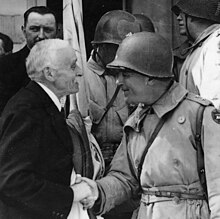
There was heavy fighting on the Cotentin Peninsula, west of the beaches, shortly after D-Day.
The Allies urgently needed the port of シェルブール at the tip of the peninsula, and sent an American force to take it. Other Allies kept much of the German armor tied down around Caen, preventing it from them joining the battle on the peninsula and attacking the Americans from the rear. However the Americans still faced a difficult fight; four German divisions were on the peninsula, and terrain there is largely unsuitable for tanks so a lot of hard foot slogging was required.
Hitler, against his generals' advice, ordered German forces to defend the whole peninsula rather than withdrawing to strong positions around the city. They did that and made the Americans fight for every bit of ground, with heavy casualties on both sides. Later Hitler commanded the defenders to fight to the last man, sacrificing themselves for the Fatherland. However when the situation became hopeless, General von Schlieben fought a delaying action while his troops demolished the port, then surrendered rather than let his remaining men die pointless deaths.
Cherbourg fell at the end of June; it was the first major French city liberated, and Caen the second.
After Cherbourg, the Americans turned south to take Saint-Lô at the base of the peninsula against stiff opposition; the town was thoroughly destroyed. Other units swept down the West side of the peninsula taking Coutances, Granville そして Avranches.
American breakout
The American victories on the peninsula got them out into open territory more suited for tanks, and they then moved quickly in several directions.

By this time nearly all German reserves had been committed in unsuccessful attempts to hold Caen and Saint-Lô, and many German formations had been badly chewed up. Some German units were tied down fighting the British and Canadians, four whole divisions had been wiped out by the Americans on the peninsula, and both the French Resistance and Allied bombing raids disrupted German efforts to bring in reinforcements.
The Americans had both more tanks and far better air support than the enemy; they used these advantages to full effect in a textbook example of fast-moving armoured tactics, similar to the 電撃戦 (lightning war) with which the Germans had devastated several countries a few years earlier. Part of the American force swung west to take Brittany with little resistance. Other units, most of the American force plus three British amoured divisions, moved south to ナント そして アンジェ on the Loire and east to ル・マン そして Alençon, despite much more serious opposition.
In early August they took part in the battle around Falaise, and by the end of August they had liberated パリ.
Falaise

ザ・ decisive battle of the Normandy campaign was fought around Falaise, some distance inland of Caen, in the first half of August.
Over 100,000 German troops were almost surrounded in the "Falaise Pocket". Commonwealth forces by now held everything around Caen on the north side and the British had taken the area around Vire on the west, while the rapid American advance had put them on the south side. Among other German forces, the pocket had those retreating after defeats in the intense battles for Caen, Saint-Lô and Vire. The Allies hammered them from the air and with artillery, pressed in with armour and infantry, and hoped to completely surround them by closing off the only exit, the "Falaise Gap" on the east.
To close the gap the Canadians thrust south near Falaise and Americans moved north in the アルジャンタン 範囲。 However the by-now-desperate Germans fought hard to keep the gap open and escape through it; there was more than a week of extremely heavy fighting before it was finally closed.
Falaise is a distinctly controversial battle; two decisions by the senior generals kept the Allies from closing the gap sooner and having an even larger victory:
- Patton's Americans were ordered to stop their advance and dig in near Argentan, rather than risk over-extending their lines by continuing north to join up with the Canadians. One reason for this was that the Allies knew from the code breakers at Bletchley Park that the Germans were planning an attack near Argentan.
- The British reserves were not sent to reinforce the Canadians who appealed urgently for them.
These decisions were heatedly debated at the time; Patton and the Canadian generals were furious. Even with the benefit of hindsight, experts still disagree over whether they were sensible and prudent or foolish and costly.
The Canadians and Poles — unassisted on the ground, though they did get plenty of air support — could neither close the gap completely nor hold against German efforts to batter their way out. They did try and got quite badly mauled; they lost more men around Falaise than they had either on the beaches or in the battles around Caen. There were many panzer divisions in the pocket; at one point six of them were defending Falaise. By now all were badly damaged but they could still mount devastating thrusts against chosen targets.
On the German side, Hitler overruled the generals who wanted to conduct an orderly retreat early in the battle, ordering them instead to hold their ground and even mount counterattacks (the red arrows on the map). Most historians believe the generals were right, a German defeat was inevitable, and Hitler's interference only made it worse. In particular, ordering tanks withdrawn from the defense of Falaise for use in his counter-attacks cost the Germans dearly.
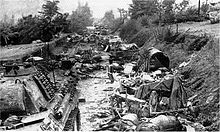
The battle was utterly devastating to the countryside.
I was conducted through it on foot, to encounter scenes that could be described only by Dante. It was literally possible to walk for hundreds of yards at a time, stepping on nothing but dead and decaying flesh. — Eisenhower
Falaise was a major Allied victory; about 10,000 Germans were killed and 50,000 surrounded and forced to surrender; some did escape to fight on, but they lost nearly all their equipment and many were wounded. After Falaise, the Germans had no effective force west of the Seine and what troops they did have in the area were in full retreat; Paris was liberated only days later.
Overall result
The campaign in Normandy that began with D-Day and ended with Falaise was a major success for the Allies. Their losses were heavy — about 200,000 killed, missing, wounded or captured — but German losses were more than twice that. Both sides lost many tanks, guns, vehicles and other supplies, but at this stage of the war the Allies could better afford those losses.
After Normandy
After Normandy, Allied forces drove toward パリ from Normandy and the Pays de la Loire which the Americans had taken after breaking out of the peninsula. After Falaise, the German forces in the area were in severe disarray and the Allies still had air superiority so the advance was rapid. The German garrison in Paris surrendered on August 25.

Meanwhile American and Free French forces, plus some British paratroopers, invaded southern France (east of マルセイユ) in mid-August. Between that and the victories in the north, they soon liberated much of France.
After that, the British and Americans drove through eastern France and then into central Germany, aiming for Berlin. The Canadians took the left flank, liberating coastal parts of France, then Belgium, Holland and the North Sea coast of Germany. In the last few days of the war a Canadian parachute battalion who had been among the first to land on D-Day were sent on a mad dash to take Wismar on Germany's Baltic coast, getting there just in time to prevent the Soviets from taking that region and possibly デンマーク.
After Falaise and the liberation of Paris, the Germans regrouped and were able to put up a stiff resistance and even mount some counterattacks; the Allied advance slowed down, but it was unstoppable. Caught between the Russians on the east and the Western Allies on the west, losing on both fronts and being heavily bombed as well, Germany surrendered less than a year after D-Day, in early May 1945.
墓地
Beautiful cemeteries overlook the sea and countryside and are essential stops along the way to understand and reflect on the human cost of the war. This was enormous; around 100,000 soldiers (about 60,000 German and 40,000 Allied) died in Normandy during the summer of 1944. There were also air, naval and civilian deaths, plus large numbers wounded or captured.
We list the cemeteries in two groups; the first four near the coast and the rest further inland. Order within each group is east-to-west.
.JPG/220px-Bény-sur-Mer_Canadian_War_Cemetery_(8).JPG)
- 4 Ranville War Cemetery, 5357 Rue du Comté Louis de Rohan Chabot. This cemetery has mainly men of the British 6th Airborne Division who made parachute and glider landings in the area on D-Day. There are 2,235 Commonwealth graves (the division had a Canadian battalion), plus 330 German and a few others.
- 5 Hermanville War Cemetery. This cemetery has 1,003 graves, mainly of British troops who fell in the first few days of the invasion.
- 6 Beny-sur-mer Canadian War Cemetery. Just over 2,000 Canadians are buried here; nearly all of them fell during the landings or shortly after. The cemetery is near the village of Reviers, about 18 km east of Bayeux.
_remembers_D-Day_(Image_3_of_7).jpg/220px-Flickr_-_DVIDSHUB_-_USACAPOC(A)_remembers_D-Day_(Image_3_of_7).jpg)
- 7 Normandy American Cemetery, ☏ 33 2 31 51 62 00. 09:00-18:00. Overlooking Omaha Beach, this 172.5 acre (70 hectare) cemetery contains the graves of 9,387 American soldiers. The rows of perfectly aligned headstones against the immaculate, emerald green lawn convey an unforgettable feeling of peace and tranquility. The beaches can be viewed from the bluffs above, and there is a path down to the beach. On the Walls of the Missing in a semicircular garden on the east side of the memorial are inscribed 1,557 names. Rosettes mark the names of those since recovered and identified.
- 8 Banneviile-la-Campagne War Cemetery. This cemetery has 2,170 Commonwealth dead and five Poles. Most fell after the capture of Caen in mid-July.
- 9 Grainville-Langannerie Polish Cemetery. This is the only Polish war cemetery in France. It has the graves of 696 soldiers from the Polish armoured division who fought alongside the Canadians in Normandy; most fell in the fight around the Falaise Gap.
- 10 Bretteville-sur-Laize Canadian War Cemetery. This cemetery is near Falaise and has 2871 Canadians, most of whom fell in the fight to close the Falaise Gap.
- 11 Saint Manvieu War Cemetery. This cemetery has 1,627 Commonwealth graves and 555 German. It is near the airport at Carpiquet and has mainly men who fell in the fierce battles over that.
- 12 Bayeux War Cemetery. The largest British cemetery of the Second World War in France, containing the graves of over 4,400 Commonwealth soldiers, mostly British, and 500 others, mostly German. The Bayeux Memorial stands opposite the cemetery and bears the names of 1,808 Commonwealth soldiers who have no known grave. The cemetery is about a 15-minute walk from Bayeux train station.
- 13 La Cambe German War Cemetery. This site has the graves of 23,400 German soldiers, most of whom fell in the Normandy campaign.も参照してください German government site.
- 14 Orglandes German War Cemetery. This cemetery has just over 10,000 German graves, including many who fell in the defense of the Cotentin Peninsula. German government site
Nearly all the dead in these cemeteries fell sometime between the invasion on June 6 and the end of the Falaise battle in mid-August.
次へ
From this area, one might go anywhere in フランス or across the channel to the イギリス. ノルマンディー is a major tourist area with a range of attractions, as are nearby Brittany、 Pays de la Loire、 そしてその チャネル諸島.
Other places of possible interest to war buffs are the scenes of two Allied raids on the German-held French coast in 1942. A predominantly Canadian force attacked ディエップ, further north on the Normandy coast, and British commandos raided Saint-Nazaire、近く ナント 南に。 Losses were extremely heavy in both places and arguably both raids were disasters, though the Saint-Nazaire attack did knock out an important drydock for the rest of the war. On the other hand, it is often claimed that these raids were essential preparation for D-Day, tests of German defenses that gave intelligence required for planning the invasion.
People interested in earlier history can see sites associated with William IV of Normandy, who invaded England in 1066 and is known there as 征服王ウィリアム。 He was born in Falaise and is buried in カーン which was his capital; his castle is now a tourist attraction. His invasion fleet sailed from Bayeux and a museum there has a famous tapestry depicting his conquest of England.
